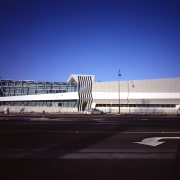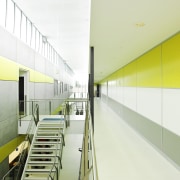Arresting landmark
The new Bendigo Police Station asserts a strong public presence and the building's complex facade addresses as many design issues as it has angles

An important part of policing is simply making your presence felt. Applying this to architecture, a dramatic, contemporary police station with a powerful visual profile can be a symbol of reassurance in a community. As with many civic buildings today, it is also important that law enforcement agencies show they are keeping pace with the times by incorporating sustainable design features into all new police stations.
Bendigo Police Station is a picture of planes and angles. Designed by FMSA Architects, with project director Greg Anson at the helm, the highly articulated design addresses several requirements, not least public prominence and sustainability. The new station stands on a high-profile corner site on the eastern side of Bendigo, one of Victoria's fastest-growing municipalities.
The building is predominantly constructed in steel, glass and pre-finished cement sheet. Viewed from the street, one half of the elongated structure is encased in folding glass, the other a near-mirror reflection in concrete panel, with a zigzag element dividing the two.
Anson says the new facility, the largest stand-alone police station in Victoria, accommodates a merging of operational police groups from four different locations.
"The building provides high-quality muster areas and offices for the various police divisions, ancillary spaces, prisoner holding and interview rooms and a clearly defined, accessible public entry foyer," says Anson. "A large common atrium, like an internal street, provides floor-plan relief and natural light, while assisting with orientation for the building's users. The atrium is also a meeting place for casual interaction, and has even been appropriated for use as an indoor cricket pitch."

The master plan is largely defined by the specific operational requirements of its users, Anson says.
"For example, muster areas and offices occupy the glassed side of the station, while elements such as interview rooms and holding cells are enclosed for privacy."
Seen in symbolic terms, the building's glass double-layered facades support the dichotomy of a modern police force that requires 24-hour operational security and street surveillance, while simultaneously presenting an accessible and transparent public image.
Besides augmenting specific interior police functions, the steel-framed, sculptural double facades act as an environmental device to significantly reduce energy consumption. They achieve this by seasonally shading the western and northern inner spaces of the building to create a controllable thermal buffer zone where windows can be opened to access cooler, or warmer air, depending on the season. The zone provides a degree of separation, and so protection, from the street and this includes protection from noise within the context of the busy inner-city location.
This glassed zone is also planted with climbers supported on vertical wires to create a terrarium effect within the depths of the facade. Relief air for the double facade is supplied from the main atrium via the office spaces or from low-level vents in the facade.

"The building is highly automated and integrated with manual overrides," says Anson. "For example, when the windows are opened, the air conditioning system shuts down and other building components respond accordingly."
Automated windows, lighting controls, blinds, ceiling fans, facade venting, and other mechanical systems are all controlled by the building management systems. In addition, rainwater is collected for landscape irrigation and car washing.
In the design, acknowledgement is given to the historical owners of the land, the Djadjawurrung people with reference to their culture introduced through specific plantings, storyboards and integrated artwork.
Credit list
Architect
Construction
Building surveyor
Cladding
Facade engineer
Hardware
Wallcoverings
Paints
Interior designer
Structural engineer and ESD consultant
Landscape architect
Roofing
Glazing
Flooring
Ceiling
Security consultant
Story by: Charles Moxham
Home kitchen bathroom commercial design





